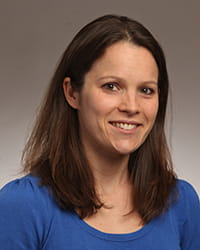Dysfunctional Ribosome Gene Linked to Rare Craniofacial and Limb Abnormalities
A Cincinnati geneticist’s exploration of rare cranioskeletal malformations and abnormal limbs in three patients worldwide has led to a dysfunctional gene as the culprit and a name for the syndrome -- acrofacial dysostosis, Cincinnati type.
K. Nicole Weaver, MD, a geneticist with the Division of Human Genetics, said the severity of a Cincinnati patient’s craniofacial abnormalities and discovery of a suspicious gene led her on a worldwide search for answers for the child’s family. A German colleague scoured a large database of patients with undiagnosed craniofacial anomalies and identified two additional patients with a defective copy of the same gene, POLR1A, which is involved in ribosome biogenesis. Ribosomes play an essential role in the process of synthesizing proteins that support cell growth. A Missouri genetics colleague studied zebrafish with absent polr1a expression, and the fish developed skull, facial, jaw and limb abnormalities similar to those in the children.
Discovering similar cranioskeletal abnormalities in zebrafish lacking expression of polr1a provided “pretty strong evidence that dysfunction of this gene could cause these problems in a human,” says Weaver, whose findings were published online April 23, 215 in the American Journal of Human Genetics.
The defective POLR1A gene, the team found, resulted in a deficiency of neural-crest-derived skeletal precursor cells that led to the craniofacial anomalies.
“It’s unclear why the dysfunction of this ribosome gene gene affects only certain parts of the body,” she says. Follow-up research will try to reproduce the anomalies in mice as a way to learn more about the role of ribosome malfunction in human development.
“For this patient, it was really important to be able to tell the family why this abnormality happened, that it wasn’t inherited and that it likely would not happen again in another child,” she says. “And the patient is doing really, really well.”





